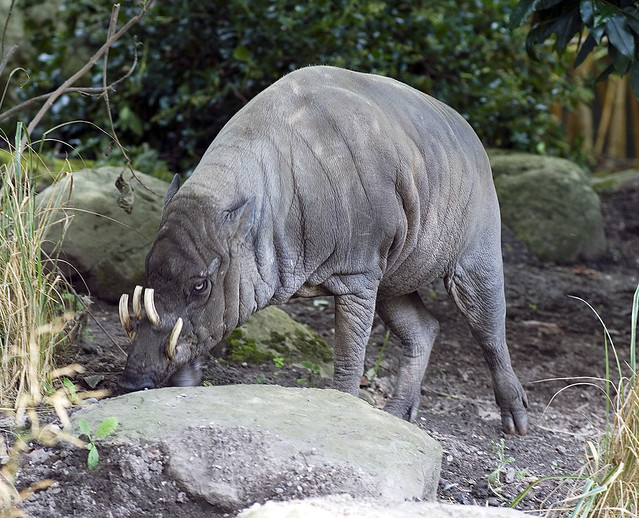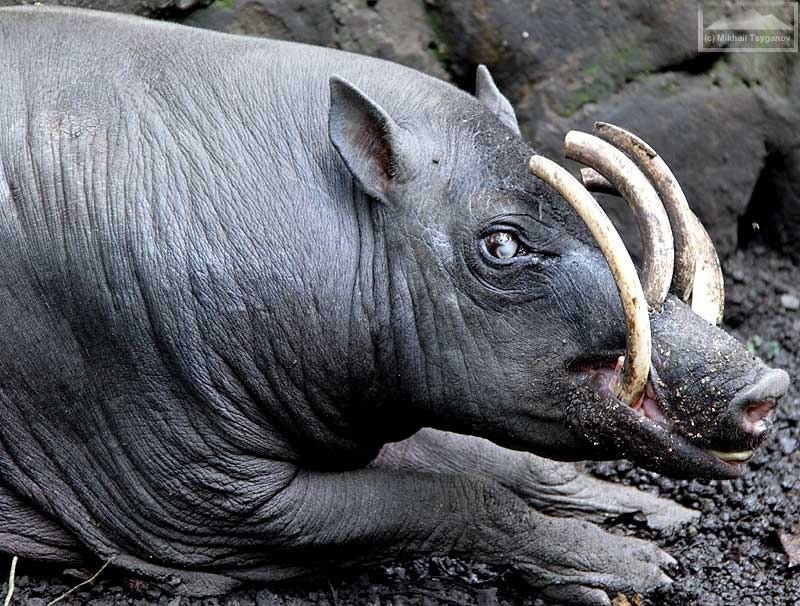Togian babirusa
The Togian Hirscheber ( Babyrousa togeanensis ) is a type of Hirscheber ( genus Babyrousa ). He is regarded as endangered and only upstream of the Sulawesi Togean Islands is known.
Features
The Togian Hirscheber seems to be the largest living species of Hirscheber According skull compare. However, no direct measurements of the total body size. The species differs from Sulawesi Hirscheber by the hairy tail tuft. As with this skin is hairy only very sparse. The third living species, the Molucca Hirscheber other hand, is considerably more hairy. The most striking feature are the canines of the upper jaw, like to poke at all deer Bern through the skin up to the outside. Compared to the other Hirscheber types but these are not bent arcuately rearwardly curved, but relatively short- forward. In addition, there are differences in the structure of molars.
Dissemination
The Togian Hirscheber occurs only on the belonging to Indonesia Togean Islands in Sulawesi. You can find it here on Batudaka, Togean, Talatakoh and Malenge. Traces were also found on the small island located north of togain Kadidiri. The islands are separated from Sulawesi 12,000 years. It is unclear whether the Hirscheber Togeans are closely related to the deer Bern, who live on the eastern arm of Sulawesi. Possible that the animals were transferred from humans to Togean Islands or reached this floating.
Way of life
Little is known about the way of life. Like other Hirscheber he inhabits tropical rain forests, preferring the banks of rivers and water- plant-rich pools. It has Togian Hirscheber beyond observed on agricultural land at village edges, in secondary forests and on beaches. The animals feed demonstrably of rhizomes and fallen fruits, such Pangium edule, Dracontomelon, Mangifera, and Spondias dulcis Artocarpus, but also cocoa and tamarind. The coconut palm is one of the food plants, but it is unclear whether the animals eat the young shoots or the fallen fruits. About the reproduction behavior is virtually unknown. It should closely correspond to the Sulawesi Hirschebers. Random observations by farmers suggest litter sizes of about 2-3 pups. Not studied in detail is the rest of social behavior. According to the local people, the animals, individually, in pairs or roam in small groups of one male and a few females seem. These are usually also in each case several pups. Most observations were made in the morning hours.
System
The Togian Hirscheber was originally described as a subspecies of Babyrousa bayrussa. This type which originally covered all Hirscheber was later split into several species, including the Togian Hirscheber.
Threat and protection
Due to the very small distribution area of less than 5,000 square kilometers, and low, declining population numbers, the type of the IUCN as endangered ( Endangered ) substance. The total population is rough estimates, probably at 500 to 1000 animals. In addition, the habitats are highly fragmented, so that no part of the population is likely to include more than 250 adult animals. The greatest threat comes from the conversion of forests to cropland. Even the animals are persecuted when they eat and damage crops. Another threat are dogs that prey on the Hirscheber. For meat, the animals are, however, rarely imposes, as the majority of the inhabitants are Muslim and refuses pork for consumption. The Togian Hirscheber is protected in his home, also the Togean Islands are protected by a Marine National Park, which covers 336 773 ha marine area and 25 832 ha of land.










